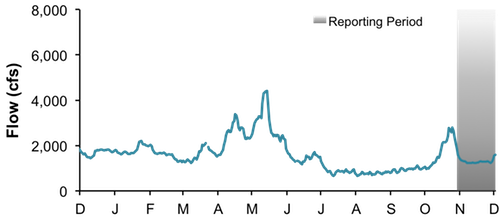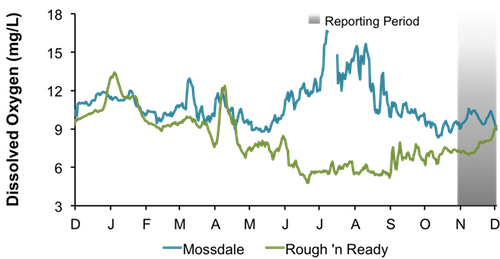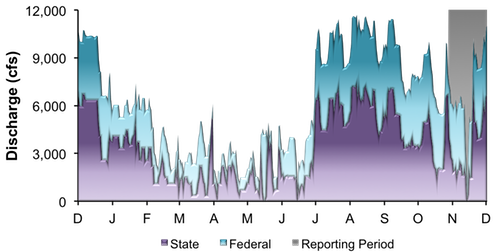| Volume 2012, Issue 4 | December 11, 2012 |
|

47th Annual Cal-Neva Conference:
April 4-6
|
|

Photo by FISHBIO |
Key Highlights
October 29 - December 2, 2012
Stanislaus River Weir Monitoring continued with 3,316 Chinook salmon passing upstream through the weir between October 29 and December 2, increasing the total to 6,867.
Tuolumne River Weir Monitoring continued with 749 Chinook salmon passing upstream through the weir between October 29 and December 2, increasing the total to 2,045.
Mokelumne River Woodbridge Dam Fish Ladder Monitoring continued with 7,631 Chinook salmon passing upstream of the dam between October 29 and December 2, increasing the total to 11,906.
San Joaquin Basin Escapement Surveys. Annual carcass surveys conducted by California Department of Fish and Game (CDFG) continued through the week of November 26.
Calaveras River Juvenile Migration Monitoring at the Shelton Road (RM 28) rotary screw trap was initiated on November 5. A total of seven O. mykiss and one yearling Chinook salmon were captured during the reporting period.
San Joaquin River Conditions. San Joaquin River flow at Vernalis ranged from 1,224 cfs to 1,834 cfs. Daily average water temperature in the San Joaquin River ranged from 53.2°F to 61.8°F at Vernalis, and from 54.1°F to 62.7°F at Mossdale. Daily average dissolved oxygen (DO) in the San Joaquin River ranged from 8.9 mg/L to 10.6 mg/L at Mossdale, and from 7.0 mg/L to 9.2 mg/L in the deep-water ship channel (measured at Rough 'n Ready Island).
Delta Exports. Combined total exports (state and federal pumps) fluctuated during the reporting period, ranging from 1,423 cfs to 10,996 cfs.
|
|
2012 Stanislaus River Weir Adult Migration Monitoring
Between October 29 and December 2 a total of 3,316 Chinook salmon were detected by the Vaki Riverwatcher as they passed upstream of the Stanislaus River weir. The  total passage to-date of 6,867 is the highest observed at the Stanislaus weir since monitoring began in 2003 (Figure 1; Table 1). Daily passage ranged between 18 and 358 Chinook salmon (Figure 2). total passage to-date of 6,867 is the highest observed at the Stanislaus weir since monitoring began in 2003 (Figure 1; Table 1). Daily passage ranged between 18 and 358 Chinook salmon (Figure 2).
Instantaneous water temperature measured at the weir ranged between 50.3˚F and 68.2˚F, and daily average water temperature at Ripon (RPN; RM 15) ranged between 52.0˚F and 60.6˚F (Figure 3). Instantaneous turbidity ranged between 0.57 NTU and 4.69 NTU (Figure 4). Instantaneous dissolved oxygen at the weir ranged between 8.60 mg/L and 12.78 mg/L, and daily average dissolved oxygen at Ripon (RPN; RM 15) ranged from 8.10 mg/L to 10.20 mg/L (Figure 5).
Daily average flows in the Stanislaus River at Goodwin Dam (GDW; RM 58) ranged from 275 cfs to 329 cfs. Flows at Ripon (RIP; RM 15) ranged from 300 cfs to 587 cfs. Note: flows downstream of Goodwin Dam may differ from dam releases due to irrigation, precipitation and other factors.
Table 1. Annual fall-run Chinook passage at the Stanislaus River weir prior to December 2, 2003-2012.
Figure 1. Cumulative passage of fall-run Chinook salmon recorded at the Stanislaus River weir from 2003-2012.Figure 2. Daily upstream Chinook passage at the Stanislaus River weir in relation to daily average flows (cfs) recorded in the Stanislaus River at Goodwin (GDW) and Ripon (RIP), 2012.Figure 3. Daily upstream Chinook passage recorded at the Stanislaus River weir in relation to instantaneous water temperature recorded at the weir, and daily average water temperature recorded in the Stanislaus River at Ripon (RPN), and in the San Joaquin River at Vernalis (VER), Mossdale (MSD) and Rough & Ready (RRI) in 2012.
Figure 4. Daily upstream Chinook passage at the Stanislaus River weir in relation to instantaneous turbidity recorded at the weir in 2012.Figure 5. Daily upstream Chinook passage at the Stanislaus River weir in relation to instantaneous dissolved oxygen recorded at the weir, and daily average dissolved oxygen recorded in the Stanislaus River at Ripon (RPN), and in the San Joaquin River at Mossdale (MSD) and Rough & Ready (RRI) in 2012.
|
2012 Tuolumne River Weir Adult Migration Monitoring
Between October 29 and December 2 a total of 749 Chinook salmon were detected by the Vaki Riverwatcher as they passed upstream of the Tuolumne River weir. The total  passage to-date of 2,045 is slightly lower than the 2,612 passages to-date in 2011 (Figure 6; Table 2). Daily passage ranged between 5 and 48 Chinook salmon (Figure 7). passage to-date of 2,045 is slightly lower than the 2,612 passages to-date in 2011 (Figure 6; Table 2). Daily passage ranged between 5 and 48 Chinook salmon (Figure 7).
Daily average flow in the Tuolumne River ranged from 165 cfs to 178 cfs at La Grange (LGN; RM 50) and 207 cfs and 339 cfs at Modesto (MOD; RM 17). Note: flows downstream of La Grange may be higher than dam releases due to accretion and Dry Creek inflow.
Instantaneous water temperature measured at the weir ranged between 53.9˚F and 63.6˚F and daily average water temperature at Modesto (MOD; RM 17) ranged between 52.7˚F and 61.3˚F (Figure 8). Instantaneous turbidity ranged between 0.28 NTU and 2.69 NTU (Figure 9), and instantaneous dissolved oxygen ranged between 10.10 mg/L and 12.01 mg/L (Figure 10).
Table 2. Annual Fall-run Chinook passage prior to December 2, 2009 - 2012.Figure 6. Fall-Run Chinook salmon cumulative passage recorded at the Tuolumne River Weir in 2009 - 2012.Figure 7. Daily upstream Chinook passage at the Tuolumne River Weir in relation to daily average flows (cfs) recorded in the Tuolumne River at La Grange (LGN) and Modesto (MOD), and in the San Joaquin River at Vernalis (VNS) in 2012.Figure 8. Daily upstream Chinook passage at the Tuolumne River Weir in relation to instantaneous water temperature recorded at the weir, and daily average water temperature recorded in the Tuolumne River at Modesto (MOD) and in the San Joaquin River at Vernalis (VER), Mossdale (MSD) and Rough & Ready (RRI) in 2012.
Figure 9. Daily upstream Chinook passage at the Tuolumne River Weir in relation to instantaneous turbidity recorded at the weir in 2012. Figure 10. Daily upstream Chinook passage at the Tuolumne River Weir in relation to instantaneous dissolved oxygen recorded at the weir, and daily average dissolved oxygen recorded in the San Joaquin River at Mossdale (MSD) and Rough & Ready (RRI) in 2012.
|
Mokelumne River Woodbridge Dam Fish Ladder Monitoring Fall-run Chinook salmon returning to the Mokelumne are counted annually by East Bay Municipal Utility District (EBMUD) as they ascend the fish ladder at Woodbridge Dam. A total of 7,631 Chinook salmon have been observed passing upstream of the dam between October 29 and December 2, increasing the passages to-date to 11,906 which is less than last years to-date passages of 18,252. Daily passage ranged between 61 and 524 Chinook (Figure 11). Daily average flow in the Mokelumne River fluctuated between 254 and 756 cfs at Camanche Reservoir (CMN) and between 98 cfs and 627 cfs at Woodbridge Dam (WBR). 
Figure 11. Daily upstream Chinook passage recorded at the Woodbridge Dam fish ladder in relation to daily average flows (cfs) recorded in the Mokelumne River at Camanche Reservoir (CMN), 2012.
|
San Joaquin Basin Escapement Surveys Annual carcass surveys conducted by CDFG continued through the week of November 12. The largest number of live fish was observed on the Stanislaus and Tuolumne River during the week of November 5, with a peak live count of 1,435 and 601 Chinook salmon, respectively. Peak live counts on the Merced River were 593 during the week of November 19.
A total of 493 redds were observed on the Merced River, 317 on the Tuolumne River, and 1,023 were recorded on the Stanislaus River. A peak in the number of redds observed for the fall-run season typically occurs in mid- to late-November. A total of 271 females have been spawned at the Merced River Fish Facility (MRFF) as of December 2.
|
2012 Calaveras River Juvenile Migration Monitoring The Calaveras River rotary screw trap at Shelton Road (RM 28) began monitoring on November 5. The trap was operated twenty days between November 5 and December  2 and a total of seven O. mykiss were captured during the reporting period. Daily catches ranged from zero to three individuals (Figure 1), and all O. mykiss captured were Age 1+ (100-299 mm) and were rated as parr (n=2) and silvery parr (n=4). Average forklengths and weights of O. mykiss are provided in Table 3. 2 and a total of seven O. mykiss were captured during the reporting period. Daily catches ranged from zero to three individuals (Figure 1), and all O. mykiss captured were Age 1+ (100-299 mm) and were rated as parr (n=2) and silvery parr (n=4). Average forklengths and weights of O. mykiss are provided in Table 3. One yearling Chinook salmon was captured during this reporting period. Instantaneous temperature recorded at the trap ranged from 48.2ºF to 58.4ºF, and turbidity ranged from 0.61 NTU to 3.48 NTU. During the reporting period, daily average combined flow from New Hogan Dam (NHG) and Cosgrove Creek (COS) fluctuated between 30 cfs and 194 cfs, and at Bellota (MRS) flow fluctuated between 0 cfs and 402 cfs (Figure 12). Table 3. Biosampling data for O. mykiss captured at Shelton Road between November 5 and December 2, 2012. Parenthesis indicates range.
Figure 12. Daily O. mykiss catch at Shelton Road, and Calaveras River flow recorded by New Hogan Dam (NHG) and Cosgrove Creek (COS) combined and flow recorded at Bellota (MRS), in 2012.
|
San Joaquin River Conditions
During the reporting period, flow in the San Joaquin River at Vernalis fluctuated from 1,224 cfs to 1,834 cfs (Figure 13). Water temperature in the San Joaquin River ranged from 53.2°F to 61.8°F at Vernalis, from 54.1°F to 62.7°F at Mossdale, and from 57.6°F to 63.9°F at Rough 'n Ready Island (Figure 14). Average daily dissolved oxygen (DO) in the San Joaquin River fluctuated from 7.0 mg/L to 9.2 mg/L in the deep-water ship channel (measured at Rough 'n Ready Island), and from 8.9 mg/L to 10.6 mg/L at Mossdale (Figure 15).

Figure 13. San Joaquin River flow at Vernalis from December 1, 2011, through December 2, 2012.
Figure 14. San Joaquin River daily average water temperature at Vernalis, Mossdale, and Rough 'n Ready from December 1, 2011, through December 2, 2012.

Figure 15. San Joaquin River daily average dissolved oxygen at Mossdale and Rough 'n Ready, from December 1, 2011, through December 2, 2012.
|
Delta Exports
Mean daily pumping at the C.W. Jones Pumping Plant (federal pumps previously known as Tracy Pumping Plant) ranged from 1,423 cfs to 4,413 cfs (Figure 16). Mean daily pumping at the Harvey O. Banks Pumping Plant (state pumps) ranged from 0 cfs to 6,719 cfs. Combined total exports (state and federal pumps) during this period ranged from 1,423 cfs to 10,996 cfs.

Figure 16. Daily exports at the state and federal pumping stations from December 1, 2011, through December 2, 2012.
|
|
|
|
|
|
|